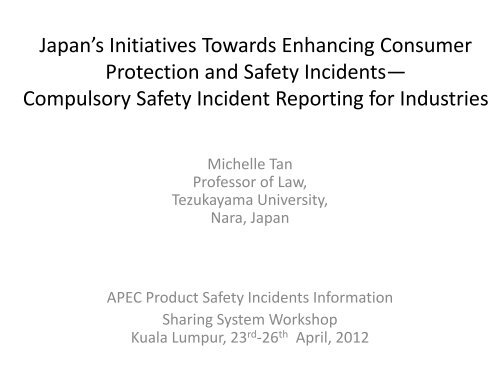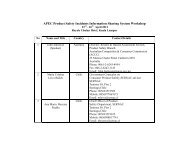Michelle Tan - Psiiss.net
Michelle Tan - Psiiss.net
Michelle Tan - Psiiss.net
You also want an ePaper? Increase the reach of your titles
YUMPU automatically turns print PDFs into web optimized ePapers that Google loves.
Japan’s Initiatives Towards Enhancing Consumer<br />
Protection and Safety Incidents—<br />
Compulsory Safety Incident Reporting for Industries<br />
<strong>Michelle</strong> <strong>Tan</strong><br />
Professor of Law,<br />
Tezukayama University,<br />
Nara, Japan<br />
APEC Product Safety Incidents Information<br />
Sharing System Workshop<br />
Kuala Lumpur, 23 rd -26 th April, 2012
What I will talk about……<br />
1. Japan’s PS law/policy<br />
2. Types of PS incident reporting<br />
3. Mandatory reporting of product incidents<br />
4. Incident/Injury Databank<br />
**The info/ views expressed herein are based on my research. Responsibility for any errors is mine.
Overview of PS law/policy<br />
• Overall framework: Consumer Fundamental<br />
Act (1968), and Consumer Safety Act (2009)<br />
• PS law is mixture of administrative law, private law,<br />
and self-regulation<br />
‣ traditionally, emphasis on admin. law and self-reg<br />
• Administrative law<br />
PS law for consumer products and food:<br />
Consumer Products Safety Act, Food Sanitation Act<br />
• Private law: PL Act (1994) based on EU Directive<br />
• Self-reg: eg. SG mark, ST mark, JIS
Administrative framework for PS<br />
• Since Sept 1, 2009 Consumer Affairs Agency(CAA)<br />
‣ collects/analyzes/ makes public incident information<br />
‣ can request related ministries to take action<br />
‣ can take action where there is an administrative “gap”<br />
• Co-operates with other gov’t ministries/agencies<br />
regarding policy, product incident reporting,<br />
collecting/ exchanging/ disseminating information
Source: http://www.caa.go.jp/en/pdf/110204framework.pdf
• 2 types<br />
Types of incident reporting<br />
1. Mandatory reporting of “consumer product incidents” by<br />
mfgers/ importers (Consumer Products Safety Act, s.35(1)<br />
‣ most consumer products covered<br />
‣ food, medicines/ pharmaceuticals, cosmetics, road transport<br />
vehicles not included<br />
2. National/ local gov’t admin. agencies required to report info<br />
to the PM(delegated to CAA) regarding actual and likely<br />
“serious incidents” (Consumer Safety Act, s.12(1))<br />
‣ information from the consumer centres via the National<br />
Consumer Affairs Centre of Japan &other relevant admin<br />
agencies<br />
‣ applies to products AND services
Mandatory reporting by industry<br />
• Required under the Consumer Products Safety Act<br />
s. 35(1) (since May 14, 2007)<br />
• Who? manufacturers/ importers<br />
• What? “serious product incidents” relating to<br />
consumer products (no duty if clearly not productrelated)<br />
• Where ? to CAA<br />
• When? within 10 days from date became aware of<br />
the incident<br />
• How ? online (via METI website), downloadable<br />
report form(Word document) on the CAA website
What is a “serious product incident?”<br />
1. Harm to a consumer’s life/person has occurred, i.e<br />
‣ death<br />
‣ injury/illness<br />
requiring treatment for 30 days or more<br />
‣ a prescribed aftereffect of an injury/illness<br />
‣ carbon monoxide poisoning<br />
2. Destruction/damage to product and potential harm to<br />
consumers i.e<br />
‣ A fire occurred (determined by Fire Dep’t)
No. of serious incident reports to date<br />
Year No. of reports<br />
2007 1190<br />
2008 1412<br />
2009 1172<br />
2010 1141<br />
2011 155 (until May, 2011)<br />
1169 (approx. final tot.)<br />
Source:<br />
http://www.meti.go.jp/committee/materials2/downloadfiles/g100420c03j.pdf<br />
http://www.meti.go.jp/committee/summary/0004589/2301_03_00.pdf
What info must be reported<br />
• Date of incident<br />
• Details of injury/damage<br />
• Details of incident<br />
• Name of product<br />
• Model/type<br />
• Amount mfg’d/imported/ sold & period<br />
• Date became aware of incident and method<br />
• Cause (where known)<br />
• Measures taken (e.g. recall)
Disclosing details of product incidents<br />
to the public (mandatory reporting)<br />
• Name of m’fgr, model, incident details made public where:<br />
‣ serious incident involves product that uses gas/oil(kerosene)<br />
(unless the product is clearly not the cause)<br />
‣ serious incidents involving other products, and the product is<br />
the likely cause<br />
• If the cause is not clear/clearly not the product a summary of<br />
the incident, not including the name of m’fgr/model, is made<br />
public<br />
• Later on, the withheld details may be made public in certain<br />
cases, such as where it is later determined after investigation<br />
that the product was the cause<br />
• Timeframe for public disclosure is approx. 5 days
How info is made public<br />
• Initially, press release (available online)<br />
• Info then made available via the Incident/Injury<br />
Databank<br />
• NITE (which investigates product incidents) also<br />
maintains its own database
Voluntary reporting by industry<br />
• M’fgrs etc. encouraged to report to the CAA (or<br />
METI) even if not sure if it is a reportable<br />
incident<br />
• Also, encouraged to report other non-serious<br />
incidents to the National Institute of Technology<br />
and Evaluation (NITE)<br />
• Retailers etc may also report incidents
Making a report on line (1)<br />
• Mft’r/Importer’s name<br />
• Type of business: □ Mft’r □ Importer<br />
• Registered mft’r □ yes □ no<br />
– If yes, name of relevant Act<br />
• Mft’r/Importer’s place of business<br />
• Mft’r/Importer’s tel. no.<br />
• Relevant dep’t name<br />
• Relevant dep’t tel. no.<br />
• Contact person’s name<br />
• Contact person’s e-mail<br />
• Industry body name(if member)<br />
• Industry body address(if member)<br />
• Industry body tel. no (if member)
Making a report online (2)<br />
• Product name (generic name e.g. “television”,<br />
“ microwave”)<br />
• Product name (brand name)<br />
• Type/make<br />
• Country of manuf.<br />
• Date of incident<br />
• Time of incident<br />
• Was there a fire? “yes” or “no”<br />
• Was there carbon monoxide involved? “yes” or “no”<br />
• Was there damage to the product? “yes” or “no”
Making a report online (3)<br />
• Injury to persons<br />
Death □ person/s<br />
Injury or illness (requiring treatment 30 days & over)<br />
□ person/s<br />
Where there are aftereffects enter no. of persons according<br />
to type: sense of visual , smell, hearing; disability of limbs;<br />
impairment of respiratory organs: urinary impairment;<br />
impairment of voice, speech, chewing; circulatory<br />
impairment; digestive impairment<br />
Injury or illness (requiring treatment < 30 days)<br />
(Below is same as for injuries above 30 days)<br />
No physical injury
Making a report online (4)<br />
• Description of incident<br />
‣ Description of circumstances (600 characters or less)<br />
• No of similar incidents occurring with same kind of<br />
product<br />
□ cases<br />
• Cause of incident<br />
□ Poor design □ Poor mf’ture □ Poor part/ ingredient<br />
□ Fatigue due to age □ Insufficient labelling<br />
□ Insufficient instructions □ Poor installation<br />
□ Other (give details in 600 characters or less)
Making a report online (5)<br />
• Measures taken to prevent reoccurrence:<br />
□stop mfg □ improve prod □ recall □ improve labels,<br />
□ cease importing □ improve mfg process<br />
□ inspection of/alteration to product □ improve<br />
instructions □ cease selling □ strengthen quality<br />
control □ warnings etc to consumers<br />
□ no action taken □ other<br />
• Preventative measures for the future<br />
(write freely, up to 400 characters)<br />
• Name and contact details of organization etc.<br />
investigating this incident<br />
• Name and address of organization in possession of the<br />
product involved
Incident/Injury Information Databank<br />
• Jointly operated by CAA and the NCAC<br />
• Covers products/services/food<br />
‣ Includes serious and non-serious incident/injury and related info<br />
• What kind of info goes into the database?<br />
‣ mandatory reporting info (see previous slides)<br />
‣ incident/ injury information from consumer centres throughout Japan<br />
(via the NCAC database)<br />
• reports from consumers about injuries/ possible injuries<br />
‣ incident/injury information comes in from relevant gov’t<br />
dep’ts/agencies/quasi-gov’t agencies<br />
• e.g. Non-serious injuries/incidents, food poisoning, car issues<br />
(malfunction etc)<br />
• No hospital injury data included at present<br />
• 58,277 incidents(includes injury) recorded to date (2009.9-2012.4.19)
Access to the<br />
Injury/Incident databank<br />
• Searchable database available to general public<br />
• But, at present, general public can not send in<br />
reports
Info available<br />
• Extent of disclosure to the public determined according<br />
to relevant law/policies covering the product/service<br />
• Info available (not all is avail., see note above):<br />
‣ Manufacturer/product, service name/details (esp. if cause<br />
known); date/place incident occurred; incident details/<br />
summary; injury details (extent, no. of injured persons);<br />
age/sex of injured; status of any investigation into cause;<br />
status of measures initiated(e.g. recall); source of info, date of<br />
registration of info, date info received, photos of product etc.
Ministries/ Agencies sending<br />
information<br />
• Consumer Agency<br />
• National Consumer Affairs Centre of Japan (NCAC)<br />
• Regional government consumer centres<br />
• Ministry of Health, Labour and Welfare<br />
• Ministry of Agriculture, Forestry and Fisheries<br />
• Ministry of Land, Infrastructure, Transport and Tourism<br />
• Ministry of Economy, Trade and Industry (METI)<br />
• National Institute of Technology and Evaluation (NITE)<br />
• Japan Legal Support Center<br />
• National Agency for the Advancement of Sports and Health
Consumer Affairs Agency and the Incident/Injury Information Data Bank<br />
Source: http://www.caa.go.jp/en/pdf/100215information.pdf
Thank you!




